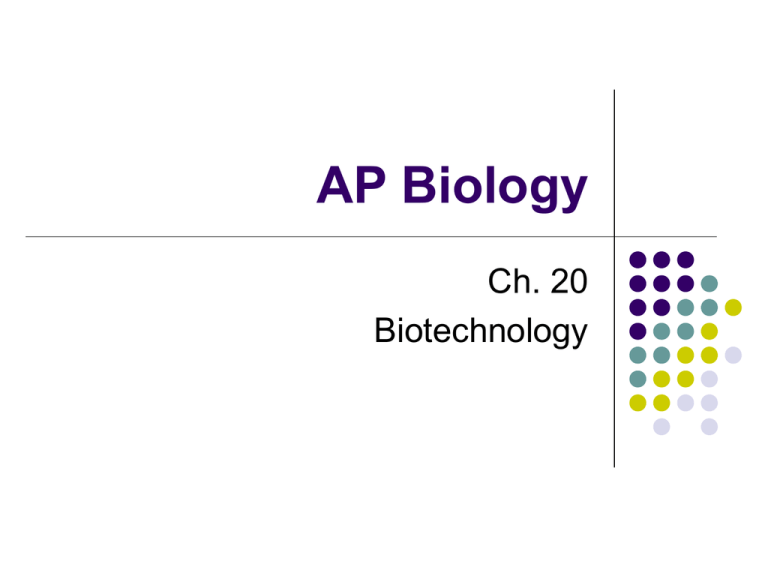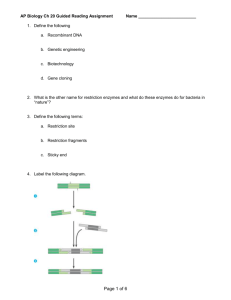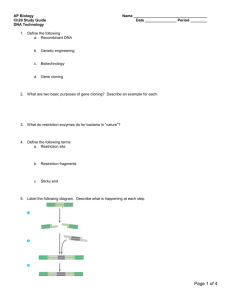AP Biology Ch. 20 DNA tech
advertisement

AP Biology Ch. 20 Biotechnology DNA Cloning DNA cloning and other techniques can be used to manipulate and analyze DNA and to produce useful new products and organisms. DNA cloning permits production of multiple copies of a specific gene or other DNA segment. Restriction Enzymes to Make Recombinant DNA Bacterial restriction enzymes cut DNA molecules within short, specific nucleotide sequences to yield a set of double-stranded DNA fragments with single-stranded sticky ends. The sticky ends on fragments from one DNA source can base-pair with complementary sticky ends on fragments from other DNA molecules. Using restriction enzymes and DNA ligase to make recombinant DNA Cloning a Eukaryotic Gene in a Bacterial Plasmid A recombinant plasmid is made by inserting restriction fragments from DNA containing a gene of interest into a plasmid vector that has been cut open by the same enzyme. Gene cloning results when the recombinant plasmid is introduced into a host bacterial cell and the foreign genes are replicated along with the bacterial chromosome as the host cell reproduces. Overview of gene cloning with a bacterial plasmid Cloned genes, cont. A clone of cells carrying the desired gene can be identified with a radioactively labeled nucleic acid probe. Eukaryotic cells can also serve as host cells for gene cloning. < < Nucleic Acid Probe <> Cloning a human gene in a bacterial plasmid Cloned Genes Cloned genes are stored in genomic libraries, which are collections of recombinant vector clones produced by cloning DNA fragments derived from an entire genome. A cDNA library is made by cloning DNA made in vitro by reverse transcription of all the mRNA produced by a particular kind of cell. Libraries of cDNA are especially useful for working with eukaryotic genes and for studying gene expression. < < Genomic Libraries <> Expressing Eukaryotic genes Several technical difficulties hinder the expression of cloned eukaryotic genes in bacterial host cells. The use of cultured eukaryotic cells as host cells and yeast artificial chromosomes (YACs) as vectors helps avoid these problems. Polymerase Chain Reaction The PCR can be used to produce many copies of a specific target segment of DNA, using primers that bracket the desired sequence and a heat-resistant DNA polymerase. < < Polymerase Chain Reaction <> Restriction fragment analysis Restriction fragment analysis detects DNA differences that affect restriction sites. Gel electrophoresis can separate DNA restriction fragments of different lengths. Specific fragments can be identified using Southern blotting, which uses labeled probes that hybridize to the DNA immobilized on a “blot” of the gel. < < Gel Electrophoresis <> < < Southern Blotting <> Restriction Fragment Length Polymorphisms (RFLP) RFLPs are differences in DNA sequence on homologous chromosomes that result in restriction fragments of different lengths, which can be determined using Southern blotting. The thousands of RFLPs present throughout eukaryotic noncoding DNA can serve as genetic markers. RFLP analysis has many applications, including genetic mapping and diagnosis of genetic disorders. < < RFLP Allele Analysis <> < < RFLP Markers <> Mapping Genomes Entire genomes can be mapped at the DNA level. The Human Genome Project is an international research effort that involves linkage mapping, physical mapping, and DNA sequencing of the human genome and the genomes of other organisms. An alternative approach starts with sequencing of random DNA fragments, relying especially heavily on computers to assemble the sequences. The human genome is thought to have 30,000 to 40,000 genes, fewer than what was once estimated. Genome Size of Different Organisms < < Sanger Method of Sequencing DNA <> < < Alternative Sequencing Strategies <> Gene Sequences Genome sequences provide clues to important biological questions; helping researchers find new genes, probe details of gene organization and control, and answer questions about evolution. DNA microarrays allow researchers to compare patterns of expression in different tissues and under different conditions. < < DNA Microarray <> Gene sequences, cont. Genomics is the study of entire genomes; proteomics is the study of proteins coded for by a genome. Single nucleotide polymorphisms (SNPs) provide useful markers for studying human genetic variation. Practical Applications of DNA technology DNA technology is reshaping medicine and the pharmaceutical industry. Medical applications include diagnostic tests for genetic and other diseases, safer, more effective vaccines, and the prospect of treating or even curing certain genetic disorders. Pharmaceutical applications include the large-scale production of many new, and some previously scarce, drugs and other medicines. < < Gene Therapy <> DNA tech applications, cont. DNA technology offers forensic, environmental, and agricultural applications. DNA “fingerprints” obtained from RFLP or STR analysis of tissue found at the scenes of violent crimes provide evidence in trials. Such fingerprints are also helpful in resolving parenthood disputes. < < DNA Fingerprints <> DNA tech applications, cont. Genetic engineering can modify the metabolism of microorganisms so that they cab be used to extract minerals from the environment or degrade waste materials. In agriculture, transgenic plants and animals are being designed to improve food productivity and quality. < < Using plasmid vectors in agriculture <> DNA Technology: Ethical and safety concerns Several U.S. government agencies are responsible for setting policies about and regulating recombinant DNA technology. The potential benefits of genetic engineering must be carefully weighed against the potential hazards of creating products or developing procedures that are harmful to humans or the environment.





